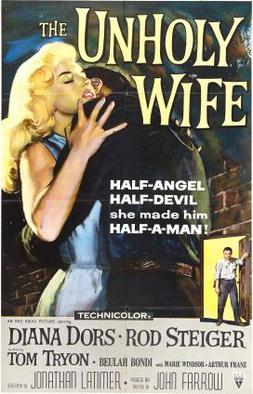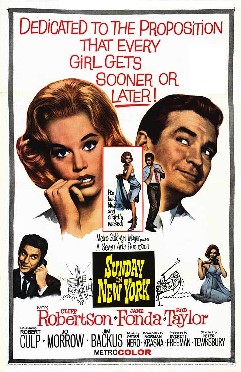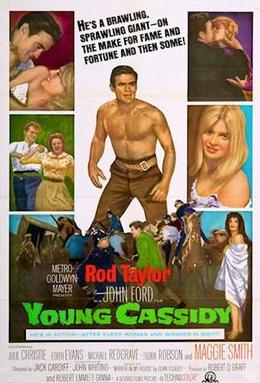
Giant is a 1956 American epic Western drama film directed by George Stevens, from a screenplay adapted by Fred Guiol and Ivan Moffat from Edna Ferber's 1952 novel.

Rodney Sturt Taylor was an Australian actor. He appeared in more than 50 feature films, including The Time Machine (1960), The Birds (1963), and Inglourious Basterds (2009), and voiced the lead role in One Hundred and One Dalmatians (1961).

Somebody Up There Likes Me is a 1956 American drama film directed by Robert Wise and starring Paul Newman and Pier Angeli, based on the life of middleweight boxing legend Rocky Graziano. The supporting cast features Everett Sloane, Eileen Heckart, Harold J. Stone, Sal Mineo, and Robert Loggia. Steve McQueen has a brief unbilled speaking role as Fidel.

Queen of Outer Space is a 1958 American science fiction feature film shot in DeLuxe Color and CinemaScope. Produced by Ben Schwalb and directed by Edward Bernds, it stars Zsa Zsa Gabor, Eric Fleming, and Laurie Mitchell. The screenplay by Charles Beaumont, about a revolt against a cruel Venusian queen, is based on an idea supplied by Ben Hecht and originally titled Queen of the Universe. Upon its release, the film was promoted by Allied Artists and distributed to some locations as a double feature with Frankenstein 1970 starring Boris Karloff

The Unholy Wife is a 1957 Technicolor film noir crime film produced and directed by John Farrow at RKO Radio Pictures, but released by Universal Pictures as RKO was in the process of ceasing its film activities. The film features Diana Dors, Rod Steiger, Tom Tryon and Beulah Bondi. The screenplay was written by William Durkee and Jonathan Latimer

The Time Machine is a 1960 American period post-apocalyptic science fiction film based on the 1895 novella of the same name by H. G. Wells. It was produced and directed by George Pal, and stars Rod Taylor, Yvette Mimieux, and Alan Young. The story is set in Victorian England and follows an inventor who constructs a machine that enables him to travel into the distant future. Once there, he discovers that mankind's descendants have divided into two species, the passive, childlike, and vegetarian Eloi and the underground-dwelling Morlocks, who feed on the Eloi.

The Virgin Queen is a 1955 American DeLuxe Color historical drama film directed by Henry Koster and starring Bette Davis, Richard Todd and Joan Collins. Filmed in CinemaScope, it focuses on the relationship between Elizabeth I of England and Sir Walter Raleigh.

Indestructible Man is a 1956 American crime horror science fiction film, an original screenplay by Vy Russell and Sue Dwiggins for producer-director Jack Pollexfen and starring Lon Chaney Jr., Ross Elliott and Robert Shayne.

Sunday in New York is a 1963 American romantic comedy film directed by Peter Tewksbury from a screenplay by Norman Krasna, based on Krasna's 1961 play of the same name. Filmed in Metrocolor, the film stars Cliff Robertson, Jane Fonda, and Rod Taylor, with Robert Culp, Jo Morrow, and Jim Backus. The score was composed and recorded by Peter Nero, who also appears as himself performing in a nightclub; Mel Tormé sang the title song.

The Catered Affair is a 1956 American comedy drama film directed by Richard Brooks and produced by Sam Zimbalist from a screenplay by Gore Vidal, based on a 1955 television play by Paddy Chayefsky. The film stars Bette Davis, Ernest Borgnine, Debbie Reynolds, Barry Fitzgerald and Rod Taylor. It was Taylor's first film for Metro-Goldwyn-Mayer after signing a long-term contract with the studio. The film score was by André Previn and the cinematographer was John Alton.

Dark of the Sun is a 1968 British adventure war film starring Rod Taylor, Yvette Mimieux, Jim Brown, and Peter Carsten. The film, which was directed by Jack Cardiff, is based on Wilbur Smith's 1965 novel, The Dark of the Sun. The story about a band of mercenaries sent on a dangerous mission during the Congo Crisis was adapted into a screenplay by Ranald MacDougall. Critics condemned the film on its original release for its graphic scenes of violence and torture.

Long John Silver, also known as Long John Silver's Return to Treasure Island, is a 1954 American-Australian adventure film about the eponymous pirate Long John Silver, with Robert Newton repeating his starring role from Walt Disney's 1950 feature Treasure Island. Newton's billing in the opening credits states, "Robert Newton as Robert Louis Stevenson's immortal", followed by the title Long John Silver.

Young Cassidy is a 1965 British biography drama film directed by Jack Cardiff and starring Rod Taylor, Julie Christie, and Maggie Smith. It is a biographical drama based upon the life of the playwright Seán O'Casey.

Planet of the Apes is a 1968 American science fiction film directed by Franklin J. Schaffner from a screenplay by Michael Wilson and Rod Serling, loosely based on the 1963 novel of the same name by Pierre Boulle. The film stars Charlton Heston, Roddy McDowall, Kim Hunter, Maurice Evans, James Whitmore, James Daly, and Linda Harrison. In the film, an astronaut crew crash-lands on a strange planet in the distant future. Although the planet appears desolate at first, the surviving crew members stumble upon a society in which apes have evolved into creatures with human-like intelligence and speech. The apes have assumed the role of the dominant species and humans are mute creatures wearing animal skins.

The Liquidator is a 1965 British thriller film starring Rod Taylor as Brian "Boysie" Oakes, Trevor Howard, and Jill St. John. It was based on the first of a series of Boysie Oakes novels by John Gardner, The Liquidator. The film follows the 1964 novel closely. Due to a legal dispute, the film's original November 1965 release was delayed to the end of 1966, by which time the spy film craze was waning.

Hell on Frisco Bay is a 1956 American CinemaScope film noir crime film directed by Frank Tuttle and starring Alan Ladd, Edward G. Robinson and Joanne Dru. It was made for Ladd's own production company, Jaguar.

Space Master X-7 is a 1958 American horror science fiction film in Regalscope from Regal Films, produced by Bernard Glasser, directed by Edward Bernds, that stars Bill Williams, Lyn Thomas, and Robert Ellis. Paul Frees, Judd Holdren, and Moe Howard have supporting roles. The screenplay was written by George Worthing Yates and Daniel Mainwaring.
King of the Coral Sea is a 1954 film starring Chips Rafferty and Charles Tingwell, directed by Lee Robinson and shot on location in Thursday Island. It was one of the most commercially successful Australian films of the 1950s and was Rod Taylor's film debut.

Trader Horn is a 1973 Metrocolor film directed by Reza Badiyi and starring Rod Taylor as the African adventurer Alfred Aloysius Horn (1861–1931). It is a remake of the 1931 film, also released by Metro-Goldwyn-Mayer. Neither picture is faithful to the original memoirs of Horn, who was 53 when World War I began.
Valley of the Dragons is a black and white 1961 American science fiction film loosely based on Jules Verne's Off on a Comet and heavily dependent on stock footage from the movies One Million B.C., King Dinosaur, Cat-Women of the Moon and Rodan. Director Edward Bernds says the film was built around stock footage from One Million B.C.


















